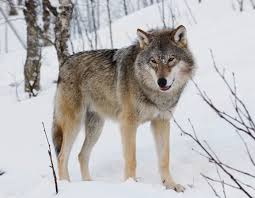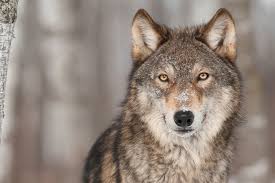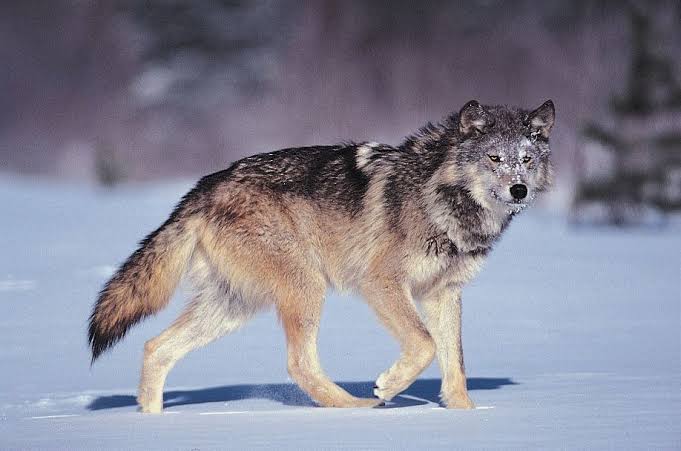Wolves scientifically known as Canis lupus are remarkable creatures that belong to the canine family. These majestic animals are known for their social nature, intelligence, and fascinating hunting strategies.
Wolves live in various habitats, including forests, tundras, and grasslands. Their fur can range from gray to brown, and they often have distinct markings on their faces, making each individual wolf unique.
In the wild, wolves form close-knit family groups known as packs. These packs typically consist of a dominant alpha pair and their offspring. The cooperative nature of wolves within a pack is crucial for their survival. They work together to hunt, raise their young, and defend their territory.
Communication is key in the wolf world. Wolves use howls, growls, and body language to convey messages to one another. Their distinctive howls serve not only as a means of communication but also as a way to mark their territory and coordinate group activities.
Wolves are carnivorous predators, with a diet primarily composed of ungulates such as deer and elk. Their hunting tactics involve strategic coordination within the pack, allowing them to take down prey much larger than an individual wolf could handle alone.
Despite their fierce reputation, wolves play a crucial role in maintaining the balance of ecosystems. Their presence helps control the population of herbivores, preventing overgrazing in certain areas. This, in turn, positively impacts plant life and various other animal species.
Wolves have long been subjects of myths and legends, often portrayed as symbols of both fear and mystique. However, it’s essential to understand the vital role they play in maintaining biodiversity and the delicate harmony of nature.
Conservation efforts are underway to protect and preserve wolf populations, which have faced challenges such as habitat loss and persecution by humans. Understanding and appreciating the significance of wolves in the natural world is crucial for ensuring their continued existence and the health of the ecosystems they inhabit.
Read Also: Why Eggs Are Good For You – The Exceptional Super Food for Your Health
Animals Affected by Wolves (Canis lupus)

Wolves, as apex predators, have a significant impact on the ecosystems they inhabit. While they are often associated with predation on ungulates, their presence influences various animal species, creating a complex web of interactions.
1. Ungulates: Wolves primarily prey on ungulates, including deer, elk, moose, and caribou. The population dynamics of these herbivores are directly affected by wolf predation. The presence of wolves helps regulate ungulate numbers, preventing overgrazing and promoting healthier vegetation.
2. Small Mammals: Wolves indirectly influence the abundance of small mammals in their ecosystems. By controlling the populations of large herbivores, they affect the availability of resources for smaller prey species. This can lead to changes in the abundance and distribution of rodents and other small mammals.
3. Birds: The presence of wolves has cascading effects on bird populations. Changes in vegetation due to wolf-induced shifts in herbivore behavior can impact bird nesting sites and foraging opportunities. Additionally, scavenging birds may benefit from wolf kills, feeding on leftover carcasses.
4. Predator-Prey Relationships: Wolves influence the behavior and abundance of other predators. In some cases, their presence may suppress smaller carnivores, creating a balance in the predator hierarchy. Conversely, the availability of wolf-killed carcasses can attract scavengers such as eagles, ravens, and smaller carnivores.
5. Plant Life: Wolves indirectly affect plant life by controlling herbivore populations. By preventing overgrazing, they contribute to the health and diversity of plant communities. This, in turn, has cascading effects on insects, birds, and other organisms that rely on specific plant species.
6. Human-Wildlife Conflict: In areas where humans and wolves coexist, the presence of wolves can impact livestock. Livestock may become targets for predation, leading to conflicts between wolves and ranchers. Efforts to mitigate such conflicts often involve implementing strategies to protect both wolves and livestock.
Understanding the intricate relationships between wolves and their ecosystem is crucial for effective wildlife management and conservation. While wolves play a vital role in maintaining balance, managing their interactions with other species, including humans, requires careful consideration to ensure the coexistence of diverse wildlife populations.
Damages Caused by Wolves

Wolves, while playing a crucial role in maintaining ecosystems, can sometimes cause challenges and conflicts, leading to perceived damages. Here are some aspects to consider:
1. Livestock Predation: One of the significant concerns related to wolves is livestock predation. In areas where wolves and domestic animals overlap, there can be instances of wolves attacking and killing livestock such as sheep and cattle. This poses economic challenges for farmers and ranchers, leading to conflicts between the interests of agriculture and conservation.
2. Wildlife Impact: While wolves contribute to biodiversity by regulating prey populations, their presence can sometimes impact specific wildlife species. For example, in regions where wolves are reintroduced after a period of absence, there may be a temporary decline in prey species as they adjust to increased predation pressure.
3. Human-Wolf Conflicts: Wolves may occasionally come into proximity with human communities, leading to conflicts. This can include attacks on pets, concerns for human safety, and impacts on recreational activities. Addressing these conflicts requires balancing the conservation needs of wolf populations with the safety and well-being of human communities.
4. Fear and Misconceptions: Wolves have historically been portrayed negatively in folklore and media, contributing to fear and misconceptions. This fear can lead to unnecessary persecution and challenges in implementing effective conservation measures. Educating communities about the importance of wolves and dispelling myths is crucial for fostering coexistence.
5. Livestock Stress: Even if direct predation is limited, the mere presence of wolves can induce stress in livestock. This stress can impact the health and productivity of domestic animals, necessitating management strategies to minimize the potential negative effects.
6. Challenges to Conservation Efforts: Controversies surrounding wolf management can pose challenges to conservation efforts. Balancing the ecological benefits of wolves with addressing concerns from local communities requires effective communication, collaboration, and adaptive management strategies.
It’s important to note that while there are challenges associated with wolves, there are also benefits to their presence in ecosystems. Conservation programs often focus on finding ways to mitigate conflicts, promote coexistence, and raise awareness about the importance of wolves in maintaining ecological balance.
Read Also: 12 Poultry Eggs Fascinating Facts You Must Know About
Control and Preventive Measures

To address challenges associated with wolves and promote coexistence, various control and preventive measures are implemented. These measures aim to manage conflicts, protect livestock, and ensure the conservation of wolf populations:
1. Livestock Guardian Animals: Using guardian animals, such as dogs or llamas, can help protect livestock from wolf predation. These animals establish a protective presence and discourage wolves from approaching domestic herds.
2. Fencing and Enclosures: Installing sturdy fencing around livestock areas can prevent wolves from accessing and preying on domestic animals. Electric fencing or specially designed wolf-proof enclosures are effective deterrents.
3. Range Riders and Herding Practices: Deploying range riders or herders to supervise and manage livestock in wolf-prone areas can deter wolves and reduce the likelihood of predation. Active herding practices can help minimize opportunities for wolves to target vulnerable animals.
4. Habitat Management: Implementing habitat management practices that reduce attractants for wolves and their prey can contribute to conflict prevention. This may involve modifying landscapes to discourage certain wildlife species or adjusting land use practices.
5. Compensation Programs: Establishing compensation programs for farmers and ranchers who experience losses due to wolf predation helps mitigate economic hardships. These programs provide financial support and incentivize tolerance for wolves in areas where conflicts arise.
6. Public Education and Outreach: Raising awareness about the ecological importance of wolves and dispelling myths through educational programs can foster understanding and support for conservation efforts. Informed communities are more likely to adopt practices that promote coexistence.
7. Adaptive Management: Implementing adaptive management strategies allows for flexibility in addressing changing circumstances. Regularly assessing the effectiveness of control measures and adjusting strategies based on new information contributes to more sustainable and successful outcomes.
8. Translocation and Population Management: In certain cases, translocating problem wolves or managing wolf populations through carefully planned programs may be necessary to address specific conflicts or concerns. This requires close coordination with wildlife management agencies.
9. Research and Monitoring: Continued research on wolf behavior, population dynamics, and ecological impacts is essential for developing effective management strategies. Monitoring wolf populations helps inform decision-making and conservation efforts.
Balancing the needs of wolves and the concerns of communities requires a comprehensive and adaptive approach. By combining preventative measures, community engagement, and ongoing research, it is possible to promote coexistence and ensure the conservation of these vital apex predators.
Frequently Asked Questions (FAQs) About Wolves (Canis lupus)
Q1: What is the scientific name of wolves?
A: The scientific name for wolves is Canis lupus.
Q2: How do wolves communicate with each other?
A: Wolves communicate using a variety of vocalizations, including howls, growls, and barks. They also use body language, such as facial expressions and postures, to convey messages within their pack.
Q3: What do wolves eat?
A: Wolves are carnivores and primarily feed on ungulates like deer, elk, moose, and caribou. They are also known to eat smaller mammals and occasionally scavange.
Q4: How big do wolves get?
A: The size of wolves can vary, but they typically weigh between 40 to 175 pounds, with males generally larger than females. Their length, excluding the tail, is usually between 4.5 to 6.5 feet.
Q5: Do wolves live in packs?
A: Yes, wolves are social animals that live in family groups called packs. A pack usually consists of an alpha pair (dominant male and female) and their offspring.
Q6: What is the lifespan of a wolf?
A: In the wild, wolves generally live around 6 to 8 years. In captivity, they can live longer, sometimes reaching up to 16 years.
Q7: Are wolves endangered?
A: The conservation status of wolves varies depending on the species and location. Some populations are listed as endangered, while others have recovered. Conservation efforts are ongoing to protect and manage wolf populations.
Q8: Do wolves pose a threat to humans?
A: Wild wolves typically avoid humans and rarely pose a direct threat. However, conflicts can arise in areas where wolf habitats overlap with human communities, leading to measures to minimize such interactions.
Q9: How do wolves contribute to ecosystems?
A: Wolves play a crucial role in ecosystems by regulating prey populations, preventing overgrazing, and promoting biodiversity. Their presence maintains a balance in nature.
Q10: Can wolves be kept as pets?
A: Wolves are wild animals and not suitable as pets. They have specific social and behavioral needs that are challenging to meet in a domestic setting. Keeping wolves as pets is often illegal and can pose risks to both the owner and the animal.
Read Also: Meaning of Online Advertising

